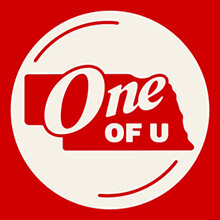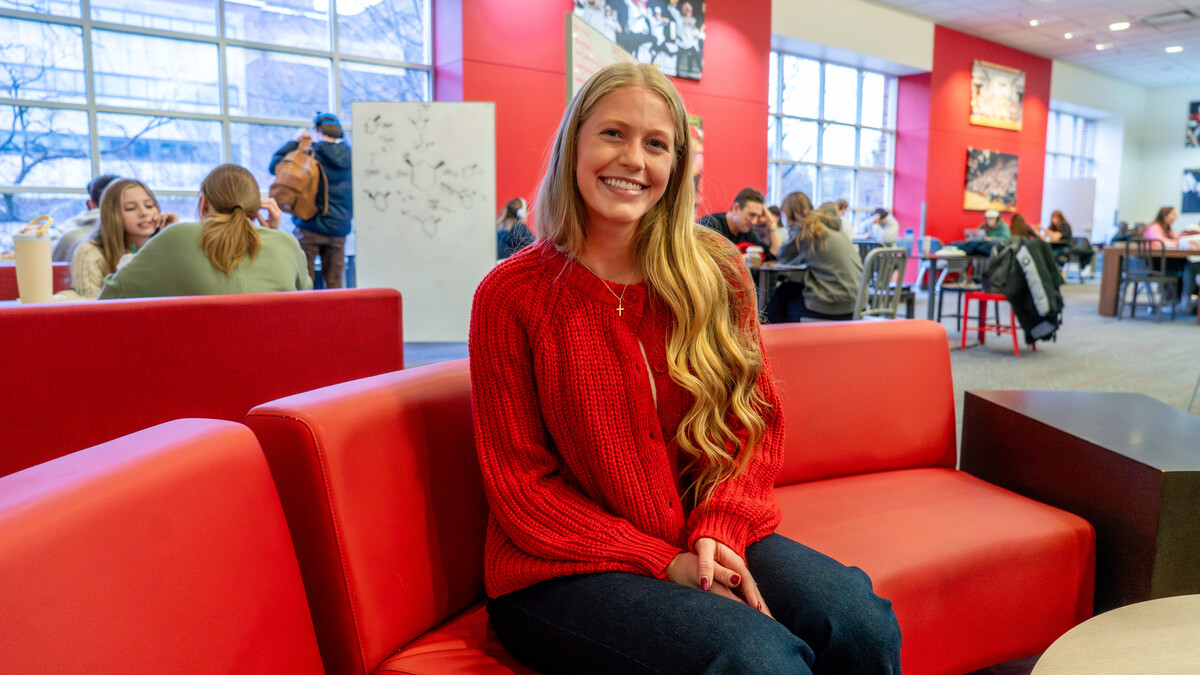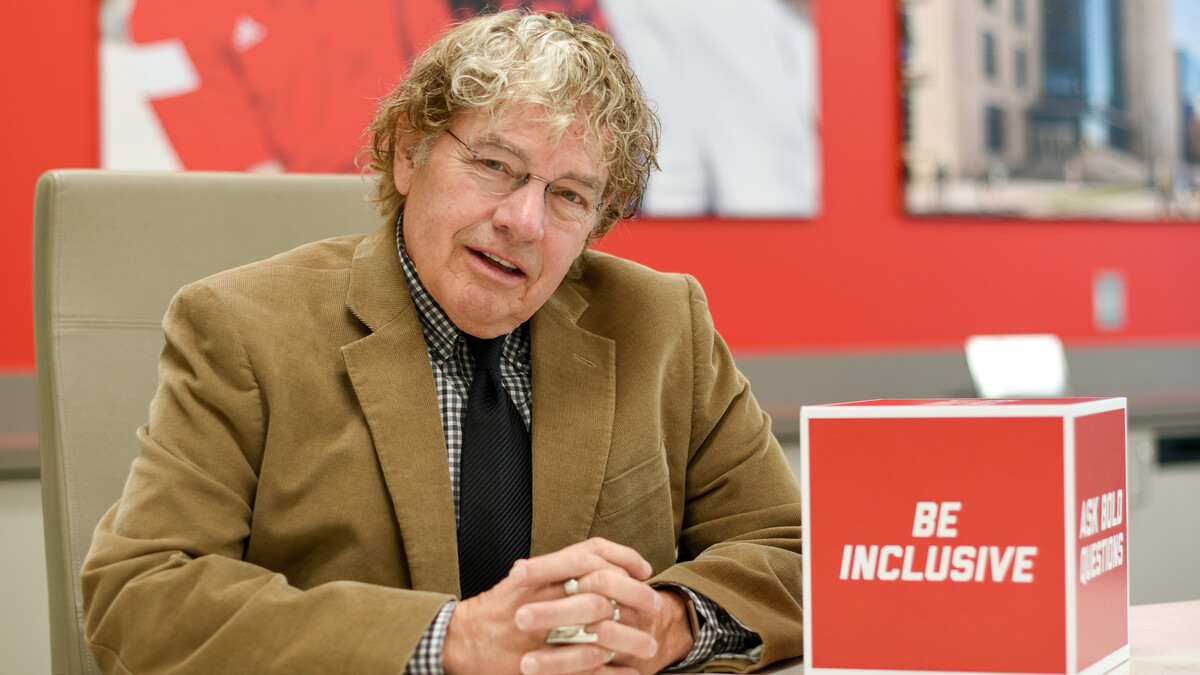
Doug Bush, assistant director of bands, has been designing marching band formations for over 40 years. When the opportunity arose to work with the Cornhusker Marching Band in the late 1970s and teach at the Glenn Korff School of Music, he jumped at the chance to fulfill lifelong dreams.

Each year, every performance, Bush marvels at the magic of the music and formations coming together. He spoke with University Communication and Marketing about some of the behind-the-scenes work that goes into each Husker game day experience.
Can you talk a bit about each of your roles — as assistant director of bands and a lecturer?
My primary role as assistant director of bands is working with the athletic bands, the Cornhusker Marching Band and the Big Red Express Pep Band.
With the marching band, I oversee all things visual. From the formations on the field to any type of choreography, I’m either writing or coordinating in some way. The band learns a new show (music, formations or other content) for each home game. Sometimes, the learning and rehearsing happens in as few as four days before the game. Things happen fast so we must be super-efficient with our time. Beyond that, I’m involved in the overall operations of the band program as a member of our faculty team. Our director of bands Carolyn Barber and associate director Tony Falcone are fantastic colleagues. I’m also the director of the UNL Campus Bands. These are concert bands offered during the spring semester that are open to all university students without an audition.
As a lecturer in the School of Music, I work with music education majors either as a class instructor or supervisor of their student teaching experiences.
What drew you to teaching in the classroom and visually designing on the field at Nebraska?
I had been designing for marching bands since the late '70s while I was still in college. It is a skill set I spent a lot of time developing and I was just in the right place at the right time. The Cornhusker Marching Band needed an assistant director who could do visual design, and I had just finished my master’s at UNL that spring. Faculty members were familiar with my work and musicianship. I interviewed for the job and the rest is history, I guess.
I knew teaching was something I wanted to do as a seventh-grade kid. The more I was involved in music, the more I wanted to teach music by being a band director.
How has the game day experience, and band performances, evolved over the years?
I’ve been the assistant director of bands since the fall of 2002. I think at its heart, the game day experience is the same as it has always been. People are drawn to sport, pageantry and large group experiences. How we deliver those commodities has changed slightly over the years and I think college athletics are at an important crossroads. It now must compete with itself in a way because of the abundance of games being broadcast. As a fan, would you rather sit and watch the game on your TV set in the comfort of your own home? Or experience it live where you can see/hear the band, the cheer squad, the other fans, etc? Because of this, bands have had to adapt as well as those involved in game day programming. We have things like drone shows and pyrotechnics happening at regular-season games. It’s kind of wild.
Through it all, the band wants to and does play a major role in the game day experience through its involvement, providing short musical selections, cheers between plays and halftime performances.
Can you talk a bit about what the preparation for game day performances is like?
Tony Falcone and I begin the process in the spring by looking at possible halftime show ideas. We also have leadership interviews and auditions for the upcoming school year as we are assembling a team. During the summer, Tony begins arranging the music for the show ideas we have selected. Once the music is arranged, I analyze it phrase by phrase, beginning to generate ideas for the visual design. I also brainstorm the best way to represent and support the music visually.
As a team, we bounce ideas off each other back and forth while also involving our color guard designer/instructor, Samantha Houston Brown. I design each show working throughout the season, so each one is customized to the number of performers we have available. About a week and a half before classes start in August, we have our band camp which runs a full day (about 10 hours of rehearsal). During camp, we learn our pregame show, so it is all buttoned down before the first game.
The first day of classes — marching band is a class — we begin working on the first halftime show by putting it onto the field. This fall we have four shows in four weeks. Each show gets the week leading up to that game dedicated to its learning/rehearsing. We rehearse each morning from 7-–8:20 a.m. in Memorial Stadium. Our percussion and color guard members begin their rehearsals at 6:30 a.m. so they can cover the additional demands of their show materials.
The visual design is notated using a software called Pyware. I’ve been using it since the early '90s, and it is the industry standard. The program won’t come up with the ideas for you — AI may take care of that at some point and I’ll be out of a job — but it makes things crystal clear as to how to best communicate with the performers. The program integrates the music with the formations so you can get a real sense of how the design will look and sound. Once a design is completed, I upload it to a package called Ultimate Drill Book. This makes it available to the performers through their iPad (along with their music) and they are then able to find their own position in the design as well as watch the animation synced with the music. This is something that has really sped up our learning process. Much better than the days of paper charts. We learn our material and get as many repetitions as we can by game day.

Take us through the schedule for a Saturday in Memorial Stadium.
We have a two-hour dress rehearsal in Memorial Stadium five and a half hours before kick-off. This rehearsal is free and open to the public. After the rehearsal, the band has a break while some of the sub-sections of the band play tailgates or other official functions (such as the Legacy Walk).
At 90 minutes before kick-off, we have an indoor meeting to warm up and go over last-minute details. One hour before kick-off, the Cornhusker Marching Band performs a concert of our halftime music in front of the Sheldon Art Museum. This concert draws lots of fans and it’s a great way to start your walk to the stadium.
About 45 minutes before kick-off, the band lines up and marches and dances to the stadium. Approximately 20 minutes before kick-off, we begin our pregame show on Tom Osborne Field. Then, there is always halftime.
Right after the game, the band will play a post-game from its seats, line up and march back across campus.
Game days are typically 12–14 hours total, but fun!
Are there any favorite memories from your time with Nebraska that stand out?
It’s so difficult to boil that down to one event. I get so much satisfaction watching our band members enjoy their time working and making music together. Watching their faces when something happens on the field during a game is always a blast. There are memories made every time I walk into Memorial Stadium for a rehearsal or a game.
Where do you draw inspiration from?
Everywhere. Movies, art, live productions, graphic design, architecture — these are all influences. Really, any place where there is creative design or staging is fertile soil for inspiration as a visual designer.
Can you put into words what it is like to see your creative work come to life in front of 90,000-plus fans?
I’m always looking to see what reaction a design will elicit. My goal is to always get a reaction, and it is magical when everything clicks.
What is your favorite performance and/or formation you have ever coordinated here at Nebraska?
Probably Fear Ameer from back in 2014. Not only was there a great live reaction, but we also gained a lot of national press. To my knowledge, nothing like that has been done by any other college band.
Is there anything people may not know, but would be interested to know about your work or the Nebraska Bands?
We have a place for everyone in the UNL Bands. You can pick your level of involvement and tailor it to your schedule or interests. And, we’re kind of cool.

______________________________________________
Editor’s Note — “One of U” is a Nebraska Today series that shines a light on the inspiring work and unwavering dedication of staff members at the University of Nebraska–Lincoln. These stories honor those who go above and beyond to support student success and strengthen our Husker community. To nominate someone for the series, please contact Troy Fedderson at tfedderson2@unl.edu.







